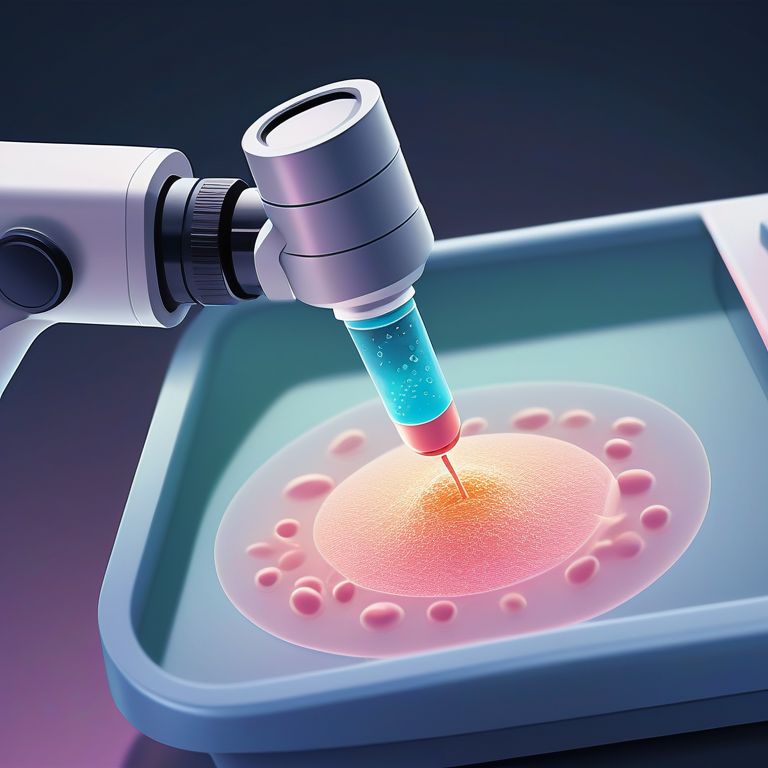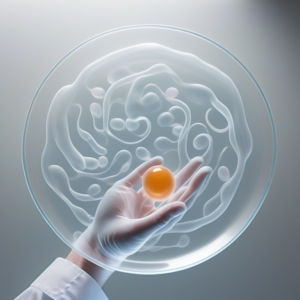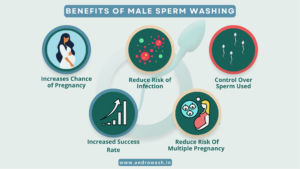Key Highlights
- Swim-Up Centrifugation is a groundbreaking technique enhancing sperm preparation for artificial insemination and fertility treatments.
- This method involves isolating highly motile sperm from seminal fluid using a density gradient to improve pregnancy success rates.
- Swim-Up Centrifugation outshines traditional sperm preparation techniques by minimizing DNA damage and maximizing viable sperm count.
- The procedure is versatile, suitable for various fertility scenarios like IUI and ICSI, offering promising outcomes for infertile couples.
- Clinics in India offer Swim-Up Centrifugation, providing a progressive approach to fertility treatments with considerations for financial planning and insurance coverage.
Introduction
Introduction:
Welcome to the easy-to-understand guide on swim-up centrifugation. This important method helps prepare sperm for different fertility treatments. In assisted reproduction, choosing the right sperm is key for increasing the chances of successful insemination.
This technique gently separates healthy, motile sperm from the semen sample. It reduces DNA damage and boosts the chance for successful fertilization. By learning about swim-up centrifugation, people facing infertility can make better choices to improve their path to starting a family.
Understanding Artificial Insemination and Sperm Preparation
Artificial insemination is a process where semen is placed into a female’s reproductive system. A key part of this is preparing the sperm. This preparation helps to improve the quality of sperm by separating moving sperm from the supporting fluid and waste.
Techniques like swim-up centrifugation help to get high-quality sperm for methods like IUI and IVF. The goal is to reduce DNA damage and increase motility, which can greatly improve the chances of successful fertilization.
Sperm preparation methods are essential in helping with infertility problems and supporting reproduction.
The Basics of Artificial Insemination
Artificial insemination is a way to put semen directly into a woman’s reproductive system.
This helps with fertilization. It helps sperm move past natural barriers. Many people use this method if the man has infertility issues or if it is a single woman or a same-sex couple wanting to have a child.
There are different techniques, like IUI and ICSI, that are used based on the specific needs of the situation. These methods are intended to improve the chances of successful reproduction. It is important to understand the basics of artificial insemination if you are looking for fertility treatments.
The Role of Sperm Preparation in Fertility Treatments
Sperm preparation is an important step in fertility treatments. It helps pick and enhance strong, moving sperm from a semen sample. This process is necessary for different assisted reproductive methods, like IUI, IVF, and ICSI. Good sperm preparation aims to increase the chances of successful fertilization.
It does this by reducing DNA fragmentation and damage in spermatozoa. Methods like swim-up centrifugation are used to collect high-quality sperm by separating them from seminal plasma and debris. This improves reproductive results in cases of male infertility.
Comparing Sperm Preparation Techniques
Density gradient centrifugation, swim-up centrifugation, and sperm washing are popular methods to prepare sperm for assisted reproduction.
- Density gradient centrifugation sorts active sperm from inactive ones by using different densities.
- Swim-up centrifugation picks moving sperm that rise from the semen.
- Sperm washing cleans the semen sample by removing impurities and debris.
Each method has its own benefits. The choice depends on issues like DNA damage, motility, and the specific needs of the fertility treatment.
Overview of Sperm Washing
Sperm washing is a process that separates active sperm from semen. This helps remove dirt or impurities for procedures like IUI and IVF. It works by using methods to reduce contamination and DNA damage. One way is through swim-up centrifugation.
In this process, doctors layer the semen sample over a special gradient medium. They then use centrifugation to isolate the motile sperm from the other parts of the sample. After this, they collect the purified sperm for use in fertility treatments. This increases the chances of successful reproduction.
Introduction to Density Gradient Centrifugation
Density Gradient Centrifugation is a method often used to prepare sperm for fertility treatments. This process involves layering solutions with different densities. It helps separate motile sperm from other things like seminal plasma and dead sperm. This separation is important because it helps reduce DNA fragmentation.
This method is especially useful when regular centrifugation fails to solve DNA damage problems in a semen sample. The supernatant that comes after centrifugation has highly motile sperm, boosting the chances of successful artificial insemination methods like IUI and ICSI.
Dive into Swim-Up Centrifugation Method
Swim-Up Centrifugation is a special way to prepare sperm for fertility treatments. In this method, a semen sample is placed on top of a gradient medium. This allows motile sperm to swim up through the solution.
As a result, motile sperm are separated from the immotile sperm and debris. This makes the concentration of high-quality spermatozoa better for treatments like IUI and IVF. It also helps reduce DNA damage and improves sperm quality. This means there is a better chance of successful conception, especially in cases of male infertility.
The Science Behind Swim-Up Centrifugation
Swim-up centrifugation is a way to prepare sperm for assisted reproduction. This method separates sperm from their surrounding fluid. It helps reduce DNA damage and boost fertility.
The healthier sperm swim up against gravity. This process helps pick better sperm samples than traditional centrifugation methods. It uses specific speeds in revolutions per minute (RPM).
This technique is important for in vitro fertilization (IVF) and intracytoplasmic sperm injection (ICSI). The clear liquid collected afterwards, called supernatant, has motile sperm that are ready for insemination. This improves the chances of successful fertilization.
How Swim-Up Centrifugation Works
During swim-up centrifugation, we put semen with active sperm on top of a special liquid. Then, we spin it quickly. The active sperm swim up and move away from other parts, as they swim faster.
After spinning, we collect the liquid above, which has the active sperm. This method is used to separate motile sperm from the semen sample. It helps lower DNA fragmentation and damage. This way, we can improve sperm quality for treatments like IUI and IVF. This really helps in fertility treatments.
Advantages of Swim-Up Over Other Techniques
Swim-Up centrifugation has clear benefits compared to old methods. It separates motile sperm from the semen sample without using high forces. This helps to lower DNA damage and DNA fragmentation.
The process is gentle, which improves the quality of spermatozoa. This is very important for IUI and ICSI treatments that help with infertility. The supernatant created is full of active motile sperm. This boosts the chances of successful fertilization during IVF procedures. That’s why Swim-Up is a top choice for fertility treatments.
Suitability of Swim-Up Centrifugation for Different Scenarios
Swim-Up centrifugation is a great way to separate active sperm while causing little DNA damage. This method is especially useful when there are worries about DNA fragmentation or low-quality semen.
It is commonly used to prepare semen samples for treatments like IUI and IVF. This ensures that high-quality spermatozoa are selected for successful fertilization. Swim-Up centrifugation gently improves motility and lowers DNA fragmentation. This makes it a helpful tool for tackling male infertility problems.
Step-by-Step Guide to Swim-Up Centrifugation
Preparing for the Procedure:
- Start with the right amount of semen sample.
- Place the sample on top of a gradient medium and use a centrifuge.
- Collect the top layer with motile sperm.
Execution of the Swim-Up Technique:
- Clean the collected sperm to get rid of any leftovers.
- Mix the sperm in a suitable medium again.
- Let the sample sit to help improve motility.
Post-Procedure Care and Considerations:
- Check the sperm concentration after centrifugation.
- Store the sperm properly to keep its quality.
Preparing for the Procedure
- Get the materials you need for swim-up centrifugation. This includes culture medium, a clean container, and a centrifuge that can run at low speeds.
- Label all containers and keep your workspace clean to protect sterility during the process.
- Carefully place the semen sample on top of the culture medium.
- Next, use the centrifuge at a low speed to separate the motile sperm from the debris.
- After centrifugation is finished, collect the liquid on top, called the supernatant, which has the motile sperm for the next steps.
Execution of the Swim-Up Technique
To use the Swim-Up technique, start by putting the semen sample on a density gradient solution in a centrifuge tube. Then, centrifuge the mix to separate motile sperm from any debris.
After that, carefully move the supernatant with the motile sperm to a new tube. Wash the sperm using culture medium with gentle centrifugation.
Finally, resuspend the sperm pellet in fresh medium to keep the sperm quality high for fertility procedures. This careful process helps reduce DNA damage and increases the chances of successful insemination.
Post-Procedure Care and Considerations
After you finish swim-up centrifugation, you must handle the samples carefully. This helps keep sperm quality high. To reduce DNA damage, store the motile sperm at the right temperature.
Do not expose the supernatant to extreme conditions. This can harm sperm motility after the process. Also, check the semen sample for signs of DNA fragmentation. This is important for its use in fertility treatments. Taking care with these details helps make swim-up centrifugation successful.
Success Rates and Clinical Outcomes
Analyzing how well swim-up centrifugation works, especially compared to other sperm preparation methods, shows good results. This technique helps reduce DNA fragmentation and improves motility.
As a result, it does a better job of providing healthy sperm for assisted reproduction forms like IUI and IVF. Real-life examples show its success in boosting fertility treatments.
This makes swim-up centrifugation an important tool for tackling infertility issues. Overall, swim-up centrifugation is a trusted method with impressive success rates.
Analyzing Success Rates of Swim-Up Centrifugation
Swim-up centrifugation is showing good results for isolating motile sperm from the semen sample. Studies say it gives better motility and less DNA fragmentation than regular centrifugation methods.
This technique is very important for improving the success of fertility treatments like IUI and IVF. To analyze success rates, we look at the percent of motile sperm collected after centrifugation and how it helps with fertility treatments.
Reducing DNA damage and recovering more motile sperm makes swim-up centrifugation a top choice for treating male infertility.
Case Studies: Real-life Success Stories
Sperm preparation methods, like swim-up centrifugation, have shown great results in real-life situations. One success story is about a couple facing male infertility caused by high DNA fragmentation in the semen sample.
Traditional methods could not produce healthy sperm for fertilization. But after using swim-up centrifugation, they saw a big boost in motile sperm and less DNA damage. This successful method helped them complete a successful IVF cycle, leading to their happy conception.
Comparison with Other Sperm Preparation Methods
Density gradient centrifugation and swim-up centrifugation are two common ways to prepare sperm. Density gradient centrifugation helps to separate active sperm from unwanted materials.
Swim-up centrifugation focuses on collecting the most active sperm directly from the semen sample. This method is different from density gradient centrifugation because it reduces DNA damage and DNA fragmentation in sperm.
As a result, it improves the sperm’s quality for assisted reproduction techniques like IUI and IVF. Studies show that this technique provides better results for sperm motility and DNA health compared to other regular centrifugation methods.
Challenges and Solutions in Swim-Up Centrifugation
Identifying common problems in swim-up centrifugation is important for getting better results. Issues like DNA fragmentation, DNA damage, and the quality of the semen sample can affect how well the process works.
Using new ideas, such as changing the centrifugation settings, can help solve these problems. Experts suggest handling samples with care. This way, you can keep motile sperm safe and lower DNA fragmentation.
Following best practices, like carefully managing the speed and time of centrifugation, can improve results. This can help in effectively dealing with infertility issues.
Identifying Common Challenges
Swim-up centrifugation is effective, but it has some challenges. One big issue is DNA fragmentation. This can cause DNA damage during the process. It’s very important to keep the right conditions to avoid this damage.
Another problem is getting enough motile sperm after centrifugation. This is especially hard in cases of male factor infertility. Also, the results can vary if the semen sample quality is inconsistent or if the technique is not done right. To handle these challenges, you need to understand the details of swim-up centrifugation well.
Innovative Solutions and Best Practices
Innovative ways in swim-up centrifugation use antioxidants to reduce DNA damage in sperm. Best practices include careful handling of the semen sample to lessen DNA fragmentation.
Using advanced methods like density gradient centrifugation before swim-up can improve the selection of motile sperm. Having strict quality control during the process and using lower centrifugation speeds can help keep sperm healthy and reduce DNA damage. These steps aim to improve results in fertility treatments and lower the chance of DNA fragmentation in semen samples.
Expert Tips for Optimizing Results
- Use fresh and high-quality media. Keep a clean and sterile environment during the process.
- Check the centrifuge speeds and times carefully to prevent DNA damage.
- Handle the semen sample carefully to protect motile sperm.
- Think about checking for DNA fragmentation after the procedure for more information.
- Choose Swim-Up Centrifugation instead of traditional methods to lower the risks of DNA fragmentation.
- Adults will benefit from customizing the process according to their individual needs.
- Following these tips can help make Swim-Up Centrifugation procedures more efficient and increase success rates.
The Future of Sperm Preparation Techniques
Emerging trends in fertility treatments show a move towards personalized methods using NLP and AI. New ways to analyze DNA fragmentation make it easier to choose the best sperm, leading to better results in assisted reproductive technologies like IVF and ICSI.
Technology is also improving to reduce DNA damage when preparing sperm, which boosts success rates in fertility treatments.
Experts think that future sperm sorting methods powered by AI will change how we select sperm for insemination. This would bring new hope to couples dealing with infertility issues.
Emerging Trends in Fertility Treatments
In the field of fertility treatments, new trends show the use of advanced technologies, such as DNA fragmentation analysis. This helps to check sperm quality in a better way.
These innovations tackle problems like DNA damage found in semen samples. They provide clearer insights for personalized treatments. Techniques that mix natural language processing (NLP) with artificial intelligence (AI) are changing assisted reproductive methods like IUI and ICSI. These changes lead to better results.
Overall, these trends show a move towards personalized medicine for infertility. They use new tools to improve the selection of spermatozoa and increase chances of having a baby.
Technological Advancements in Sperm Preparation
Technological improvements in sperm preparation use new methods to better the quality of semen samples. They focus on problems like DNA fragmentation and damage. Innovations, like swim-up centrifugation, change the way we have used conventional centrifuges before.
These methods help in quickly isolating high-quality motile sperm for treatments such as IUI and ICSI. By using these new techniques, fertility experts can increase success rates in ART procedures. This helps improve reproductive outcomes and raises the chances of conception.
Predictions for the Next Decade
In the field of sperm preparation, we can expect big improvements in the next ten years. New techniques might help in picking the best motile sperm.
They could also reduce DNA fragmentation and improve sperm quality. Using AI and machine learning may change how we analyze semen samples. This could help in finding the best sperm more accurately.
Additionally, treatments might start to focus on the individual DNA damage levels of people. These changes could lead to better fertility treatments and outcomes soon.
Conclusion
Swim-up centrifugation is an important method for preparing sperm in assisted reproduction, such as IUI and IVF. This method pulls out healthy, moving sperm while helping to lower DNA damage.
This leads to better chances of fertilization. It is more effective than traditional centrifugation because it provides higher-quality sperm with less DNA fragmentation.
This technique improves sperm quality and is vital for treating male infertility. Using modern sperm preparation methods, like swim-up centrifugation, can lead to improved results in fertility treatments.
Frequently Asked Questions
What Makes Swim-Up Centrifugation Different from Other Methods?
Swim-Up Centrifugation is a method that does not hurt the sperm. It lets the best swimmers move up against gravity. This way, we can pick the strongest sperm for fertilization. This improves the chances of success in fertility treatments.
How Long Does the Swim-Up Centrifugation Process Take?
Swim-Up centrifugation usually takes about 45 minutes to 1 hour. This method helps separate good quality sperm from seminal fluid. It is important for fertility treatments. The time taken ensures that we can get the best sperm for effective artificial insemination.
Is Swim-Up Centrifugation Suitable for All Couples Seeking AI?
Swim-Up Centrifugation is a good choice for many couples looking for Artificial Insemination. It provides a gentle and effective way to prepare sperm. However, sperm quality and specific fertility problems can affect if this method is right for you. It is important to understand your individual needs to find the best technique.
Can Swim-Up Centrifugation Improve the Chances of Pregnancy?
Swim-Up Centrifugation can improve your chances of getting pregnant. It does this by separating high-quality sperm for fertilization. This gentle method picks out motile sperm, which helps make artificial insemination more successful. This technique leads to better fertility results in different situations.
Where Can I Find Clinics Offering Swim-Up Centrifugation in India?
You can find clinics that offer Swim-Up Centrifugation in India. Look for well-known fertility centers like XYZ Clinic and ABC Hospital. These places focus on advanced fertility treatments. They help couples reach their goal of becoming parents.
Understanding the Cost Implications
Exploring the costs of swim-up centrifugation is important. This includes the costs for the procedure and any extra expenses. Prices can change based on the clinic’s location. They also depend on how complex the technique is and what resources are needed. Additionally, understanding the costs can help patients make decisions and affect treatment results.
Breakdown of Costs Associated with Swim-Up Centrifugation
Swim-Up Centrifugation costs can change depending on the clinic charges, how the equipment is used, and any extra services like sperm analysis. It is important for couples who are looking into this fertility treatment to understand these costs.
Comparing Costs with Other Sperm Preparation Techniques
Comparing the costs of swim-up centrifugation to other sperm preparation methods means looking at expenses for equipment, supplies, and staff training. Even though swim-up may cost more at first, it saves money in the long run. This is because it increases success rates and lowers the need for repeat procedures. As a result, swim-up is a smart choice for fertility clinics.
Financial Assistance and Insurance Coverage in India
Exploring financial help and insurance coverage in India for fertility treatments is important. It helps to know the costs and the support programs available to manage these expenses. It is also helpful to look at insurance policies that might cover parts of the treatment process.





